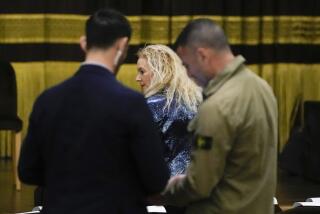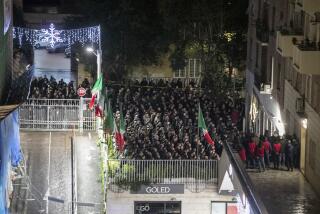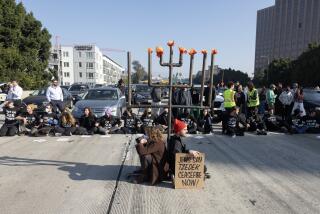Organized Anarchy in Genoa
- Share via
GENOA, Italy — Anarchists, by definition, are not supposed to be organized. But on Genoa’s embattled streets, they appear to have assumed specialized tasks inside the largest gathering of protesters ever to confront a meeting of world leaders.
They have window smashers who target banks and shops, and looters who move in amid the broken glass. When police arrive, fire-bombers duck into alleys to pour gasoline into bottles while stone-throwers gather their weapons in grocery carts. Shock troops stand shoulder to shoulder behind plastic shields to charge police lines defending the leaders of the Group of 8 industrialized nations.
For a second day Saturday, bands of anarchists slipped in and out of larger groups of marchers and provoked the police, turning peaceful protests into riots and forcing nonviolent leaders of a growing movement for global justice to question the strategy of besieging summits with huge crowds.
Italian television reported that police raided a school being used as a protest headquarters this morning. Forty protesters were injured, and 50 were arrested.
As many as 100,000 labor, environmental and humanitarian activists, most of them from Europe, came here to protest what they call a heartless U.S.-led push toward globalization that exploits and further impoverishes the world’s poorest countries.
Organizers had believed that such a multitude could isolate the few hundred violent anarchists who have routinely supplied the mayhem at such protests since the World Trade Organization’s 1999 meeting in Seattle.
They were wrong.
At least 2,000 violent protesters descended on Genoa from all over Europe--mainly men in their early 20s, hooded or masked, dressed in black and wearing motorcycle helmets or hard hats. Many belong to secretive groups with names such as Libertarian Marxists and Class War.
Hundreds of them split off from Saturday’s mass march along Genoa’s seafront walkway and attacked police officers, who fought back. The riot trapped at least 25,000 people at the rear of the procession in clouds of tear gas on a narrow strip of land between the mountains and the Mediterranean.
Mainstream protesters were furious. They lectured the anarchists like angry parents and tried to pull off their black masks, which reminded some Italians of the Red Brigade terrorists of a generation ago.
“The police let the anarchists do as they wanted, as a pretext to attack us,” said Luca Casarini, a prominent protest leader.
But the efforts to discipline the crowd failed. One man was punched in the face when he tried to stop a group of youths from setting fire to a trash bin. “They had clubs and firebombs--what were we supposed to do to get them out of the march?” asked protester Simona Tatarini, 31.
Anarchists blending into the parade stopped to smash traffic signals and rip chains from a parking lot barrier. One group even marched in orderly formation with a large banner that read, “Hate G-Eight,” not far behind a delegation from the World Wide Fund for Nature with its panda posters.
“No one anticipated the sheer size of the anarchist bloc,” said Lucy Matthew, a spokeswoman for Drop the Debt, a London-based coalition that advocates debt relief for poor countries and had mobilized about 500 people here for peaceful protest. “Our movement will be grappling with their presence for some time to come.”
In a decision she called disheartening, Drop the Debt withdrew its support for Saturday’s march after one protester was killed and many others were arrested or injured Friday. As others marched, the group held a prayer vigil in a church by the sea wall.
Bono, the lead singer of pop group U2 and the debt-relief group’s most visible activist, said he was stunned by the violence, which came as President Bush and the other G-8 leaders met with selected counterparts from developing nations to talk about how to fight poverty.
“Of all the days to destroy, they destroyed one where there was some actual dialogue happening,” Bono said after meeting with several summit leaders here--the kind of action to which the group may limit itself from now on.
The dead protester, Carlo Giuliani, 23, of Genoa, was shot as he tried to lob a fire hydrant into the open back window of a paramilitary police vehicle, which then rolled over his body.
Italian Interior Minister Claudio Scajola said the 20-year-old policeman who opened fire was already wounded and feared for his life. Authorities opened an investigation into the actions of the officer, who was hospitalized in a state of shock.
The killing was the first reported death in the summit-hopping protests that date to the late 1990s and have had powerful but conflicting effects on the global justice movement.
Some mainstream protesters said Giuliani, who had an arrest record for weapons possession and drug abuse, was exactly the kind of troublemaker who gives them a bad name. Others tried to turn him into a martyr, marching by the thousands with black armbands Saturday past a makeshift shrine in the piazza where he died.
The shrine was decorated with flowers, candles and the victim’s orange construction helmet. There and during the long afternoon march, protesters debated the usefulness of violence in their crusade.
“Violence is central to the media’s attention,” said a twentysomething Englishman who says he’s with the Libertarian Marxist anarchist group and identified himself only as James. “Unless things get smashed, nobody pays attention.”
James, seated with his brother John against the sea wall during a break from the march, said he has no problem with people who break bank windows and later admitted to running around Genoa with a gang doing exactly that.
“It’s hypocritical for anyone to condemn that sort of violence when their movement actually benefits from it,” John added.
Whether it’s despite or because of the recurring violence, the movement has, in fact, grown over the past two years, drawing pacifists and anarchists alike. Many of its causes, which include an international treaty limiting so-called greenhouse gas emissions and cheaper drugs to help poor countries fight AIDS, are gaining support in the West.
For now, the prevailing sentiment within the movement is to keep harassing summit meetings, hoping that the number of protesters will continue to grow and raise pressure on world leaders.
But for that to happen, they admit, they must sway public opinion that the police--not the anarchists--are the real troublemakers and that rich countries’ governments are the ultimate culprits.
Debate over the violence in Genoa has quickly become globalized. Friday’s fatal shooting has sparked anti-G-8 demonstrations in Canada, Greece, Germany, Spain, France and Sweden.
But Spain’s El Mundo newspaper warned that the protest movement’s credibility will survive “only if it breaks with its fearsome violent infiltrators.”
“This is a battle for legitimacy,” said Walden Bello, a University of Philippines sociologist and leading ideologue of the movement. “The rich countries are trying to preserve their legitimacy, and we’re trying to erode it.
“Yes, there’s always a part of public opinion that will be alienated by violence, but I have a sense that television audiences are looking at Genoa and asking, ‘Why are these guys fighting so hard for what they believe in?’ ”
The violence has not escaped G-8 leaders, who have made concessions on debt and AIDS relief, although not enough to satisfy the protesters.
French President Jacques Chirac said Saturday that he and his counterparts have been “traumatized” by the violence. He added, “The elected leaders of our countries have to consider the problems that have brought tens of thousands of our compatriots . . . to demonstrate their wish for change.”
“These summit meetings and the violence around them shake up people in power,” said John Cavanagh, head of the Institute for Policy Studies in Washington. “They want to figure out a way to make the problem go away. We could be entering a period where reforms are possible.”
Times staff writer James Gerstenzang contributed to this report.
More to Read
Sign up for Essential California
The most important California stories and recommendations in your inbox every morning.
You may occasionally receive promotional content from the Los Angeles Times.










